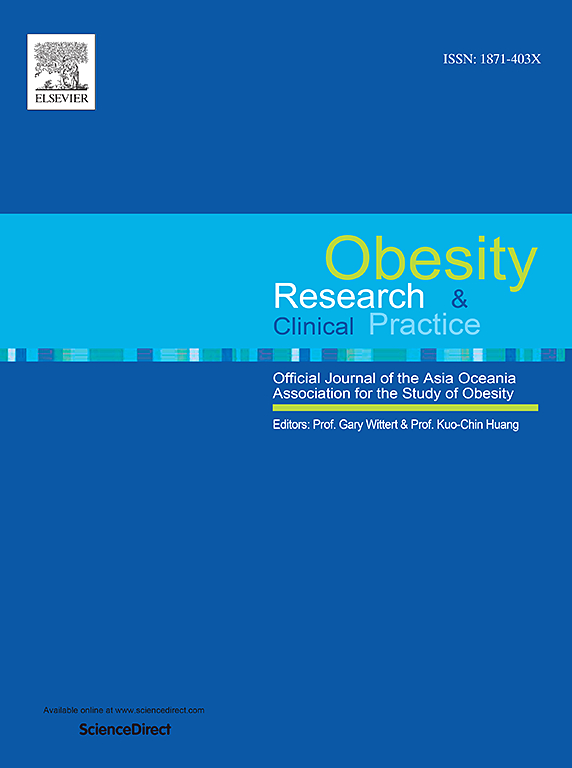Healthcare costs according to obesity and physical activity: 8-year longitudinal study among patients assisted by the Brazilian National Healthcare System
IF 2.5
4区 医学
Q3 ENDOCRINOLOGY & METABOLISM
引用次数: 0
Abstract
Introduction
Obesity is a risk factor for the development of many chronic diseases, and, consequently, it is associated with an increase in the use of health services. On the other hand, practicing physical activity reduces healthcare costs. However, the long-term roles of physical activity and obesity in healthcare costs are not well explored in the literature.
Objective
This study aimed to investigate the physical activity (PA) and obesity trajectory in relation to health costs, in participants treated by primary care, over a period of eight years.
Methods
The sample included 291 participants, aged ≥ 50 years, evaluated between 2010 and 2018. Weight and height were used to calculate the body mass index (BMI), and PA was evaluated by a questionnaire. Healthcare costs were extracted from medical records. The General Structural Equation Model (GSEM) was used to analyze the trajectory of the variables in the eight-year follow-up.
Results
In 2010, the median healthcare cost was US$51.61, an increase of 54 % compared to 2018. BMI and PA decreased by around 2 % and 22.6 %, respectively. At baseline, BMI affected the trajectory of health costs, increasing costs by US$ 1.55 (p = 0.024).
Conclusion
In conclusion, in eight years, participants presented decreases in BMI and PA and increases in health costs. BMI, but not PA, affected the increase in healthcare costs at baseline.
根据肥胖和身体活动的医疗费用:巴西国家医疗保健系统协助患者的8年纵向研究。
导言:肥胖是许多慢性疾病发展的一个危险因素,因此,它与卫生服务使用的增加有关。另一方面,锻炼身体可以降低医疗费用。然而,体育活动和肥胖在医疗费用中的长期作用并没有在文献中得到很好的探讨。目的:本研究旨在调查八年期间接受初级保健治疗的参与者的身体活动(PA)和肥胖轨迹与健康成本的关系。方法:样本包括291名参与者,年龄≥ 50岁,于2010年至2018年进行评估。以体重和身高计算体重指数(BMI),以问卷方式评估PA。医疗费用从医疗记录中提取。采用通用结构方程模型(GSEM)分析8年随访期间各变量的变化轨迹。结果:2010年,医疗费用中位数为51.61美元,比2018年增长了54. %。BMI和PA分别下降约2 %和22.6% %。在基线时,BMI影响健康成本轨迹,使成本增加1.55美元(p = 0.024)。结论:总的来说,在八年内,参与者的BMI和PA下降,健康费用增加。在基线时,BMI对医疗费用的增加有影响,而PA没有影响。
本文章由计算机程序翻译,如有差异,请以英文原文为准。
求助全文
约1分钟内获得全文
求助全文
来源期刊

Obesity research & clinical practice
医学-内分泌学与代谢
CiteScore
7.10
自引率
0.00%
发文量
80
审稿时长
49 days
期刊介绍:
The aim of Obesity Research & Clinical Practice (ORCP) is to publish high quality clinical and basic research relating to the epidemiology, mechanism, complications and treatment of obesity and the complication of obesity. Studies relating to the Asia Oceania region are particularly welcome, given the increasing burden of obesity in Asia Pacific, compounded by specific regional population-based and genetic issues, and the devastating personal and economic consequences. The journal aims to expose health care practitioners, clinical researchers, basic scientists, epidemiologists, and public health officials in the region to all areas of obesity research and practice. In addition to original research the ORCP publishes reviews, patient reports, short communications, and letters to the editor (including comments on published papers). The proceedings and abstracts of the Annual Meeting of the Asia Oceania Association for the Study of Obesity is published as a supplement each year.
 求助内容:
求助内容: 应助结果提醒方式:
应助结果提醒方式:


